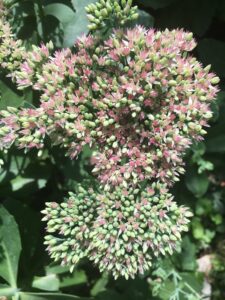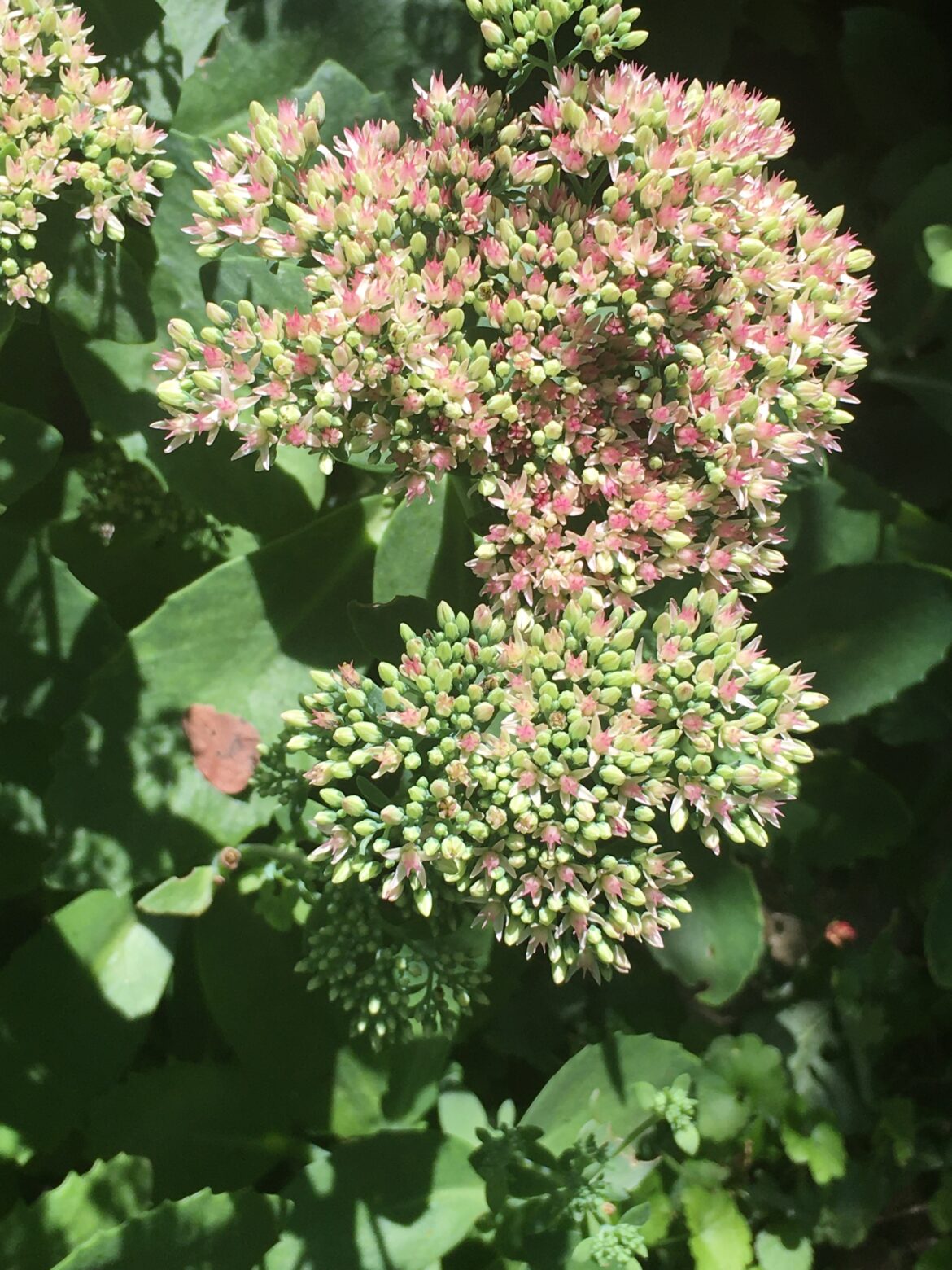August 8th
The 220th Day of the Year
The air sizzles with insect song. Crickets and grasshoppers warn and wook, rubbing their musical legs. They make the sound of beans rolling in a pan, tiny bells ringing on the ankles of dancers, fingers raked over the teeth of combs, waves rolling cobbles on the shore.
Scott Russell Sanders
Sunrise/set: 5:40/7:41
Day’s Length: 14 hours 1 minute
Average High/Low: 84/64
Average Temperature: 74
Record High: 99 – 1901
Record Low: 49 – 1889
Weather
Today’s highs are in the 90s thirty-five percent of all the years, in the 80s forty-five percent of the time, 70s the remainder of the years. The chance of rain is 20 percent. Sun dominates. Conditions may be unsettled, however, as a cool front typically passes through Ohio between today and the 12th. Chilly nights in the 40s come 15 percent of the years.
The Weather in the Week Ahead
This week’s highs: 50 percent of the afternoons are in the 80s, 25 percent in the 90s and another 25 percent in the 70s. Rainfall is typically light, with the 9th, 12th, 13th, and 14th carrying just a ten to 15 percent chance of a shower. With the arrival of the August 10th cold front, however, the 10th and 11th have a 40 percent chance of precipitation as well as the slight possibility of a high only in the 60s for the first time since July 13th. The 10th through the 14th are likely to bring evening lows below 60 degrees. And within the next seven days, lows reach into the 40s fifteen times more often than they do during the first week of August.
The Natural Calendar
Everbearing strawberries and watermelons ripen; summer apples are half picked, and tobacco is often topped on two out of three of all the plots along the Ohio River. In average years, peaches are at their best throughout the Midwest. The first soybeans are turning, and most are setting pods. The harvest of winter wheat and oats is complete throughout the nation. Farmers bring in corn for silage, dig potatoes, pick tomatoes and finish the second cut of alfalfa hay. This is the beginning of lawn seeding time, and the time for band seeding alfalfa on the farm. Smooth brome grass, orchard grass and timothy are also planted now.
The Stars
Winter’s Orion and the Summer Triangle are balanced and connected by the Milky Way. Each pulls the other to its appointed place, keeping perfect equilibrium, compressing the year into a cycle visible on the small, round dome of heaven.
Orion is the easy gauge of winter, rising with the Milky Way on November evenings, filling the southern sky throughout the night all winter, finally disappearing late in April. As Orion waxes, all of the pieces of summer recede; as that constellation wanes, each piece returns.
The Summer Triangle is the stellar gauge of summer. It is a parallel marker to Orion that clocks the unfolding of the leaves and flowers. Accompanied by the opposite end of the Milky Way, it appears on the evenings of May. Its triple constellations, Lyra, Cygnus and Aquila, contain three prominent capstone stars, Vega, Deneb and Altair, which form a giant triangle.
When all these stars come up after dark, the canopy of leaves is complete. Mock orange and peonies and iris blossom in the gardens of the Ohio Valley morning birdsong swells, strawberries ripen, sweet clover is open by the roadsides, and goslings enter adolescence along the rivers.
When Vega, Deneb and Altair are positioned overhead at midnight, then the birds are quiet, ragweed pollen is in the air, blackberries are sweet, hickory nuts and black walnuts are falling, katydids and cicadas and late crickets are singing, rose of Sharon colors the garden.
When leaves are turning all along the 40th Parallel and the last wildflowers have completed their cycles, then Lyra, Cygnus and Aquila set in the west after sundown, leading the Milky Way through Cassiopeia and Perseus, dividing the heavens into equal halves, for an instant holding in balance summer and winter, linking the Summer Triangle with Orion rising again in the east.
Daybook
1984: Virgin’s bower and Japanese knotweed blooming along the railroad tracks near the Children’s Center, velvetleaf in the soybean fields.
1986: Color shift beginning along the railroad tracks, milkweed yellows by the roadsides.
1988: Jacoby: Avens gone to burs, early white snakeroot, ragweed early full, oxeye full, spider webs across the way every few yards (peak of spider webs now), tall bellflower late, tall coneflower full, trumpet creeper holding, last of the white vervain, teasel dying back, fresh four-inch red thorns on the locust, rough bedstraw full, blue vervain seven feet high and full bloom, purple ironweed, too.
1990: Home from Florida to loud field crickets and katydids that started up while I was gone.
1992: Long and steady cardinal song before dawn, then silence.
1993: At South Glen, the wood nettle is about half gone now, leaves tattered, seeds beginning to form. Blackberries are early full for picking. Most wingstem and ironweed still not fully developed.
1996: The pieces of Late Summer fall into place. The heat stays, but the rhythm has shifted, the tones have been altered, colors and sounds and scents all pointing to September. The katydids, which started to sing last week, are in full chorus after dark. The cicadas have finally all come out and fill the afternoons. The town geese have delayed their restless flights in the cool summer, but they should start moving back and forth across town any day. The smell of the wind is becoming more pungent, sweeter, sharper as the vegetation evolves.
1997: The last of the day lilies and Asiatic lilies.
1998: The Royal Standard hostas are in full bloom now in the yard and around town.
1999: Hummingbird still coming to the rose of Sharon at 6:00 in the morning. Honeysuckle berries green, half size. Purple butterfly bush and loosestrife have both recovered from their July slump, are blooming strong. Several cottonwoods turning along the freeway, one Judas maple yellow-orange, a black walnut tree here in town.
2000: By this point in the year, so many of the notations in my natural history journal point toward fall. The notes and the actual changes accumulate until summer disappears, and a new season of new pieces emerges.
2001: Royal Standard hosta: one in full bloom, tall stems with large white trumpet flowers, one budded.
2003: No birds until 5:15 a.m. First blue Asiatic dayflower bloomed at the northwest corner of the house this morning.
2004: Greg called, said he saw a green cicada emerging today. I noticed a new green cicada on the back arbor the other day, didn’t realized it had just come out of its shell – which was a few feet away. These are late-emerging annuals. About town, several more Judas maples are turning.
2005: Cardinals began singing at 5:00 a.m., gathered momentum for half an hour, then quieted to sporadic through the day. Crescent-spot butterfly found on the showy coneflowers this afternoon; it remained there for at least an hour while I searched to match its markings in my butterfly book. Monarchs and tiger swallowtails and spicebush swallowtails continue abundant in the garden.
2006: Katydids still sang until 4:40 a.m. First cardinal at 4:59. The black walnut tree in the school park has lost maybe a third of its leaves.
2007: The last lily in the yard has wilted. Some euonymus flowers turning to berries. Several branches on the southwest redbud seem to have died, foliage withered. One dead branch also on Janet’s redbud.
2010: Cardinal heard at 5:05, robin singsong when I went outside at 5:20. Tiger swallowtails all day, a few monarchs. Driving in to Dayton, we saw pale Judas maples, blanching sections of cottonwoods, yellowing milkweed leaves.
2011: Portland, Oregon: Linden tree fruits dropping, crunching as we walked the suburbs this afternoon. No insect song throughout the day and night, only occasional crows and a few other calls unrecognized.
2012: Some turning of the maple trees noticed on our drive into Dayton this morning, the changes complementing the slight yellowing of the cottonwoods. In the alley, small-flowered coneflowers and Mrs. Timberlakes’s feverfew are in full bloom, but the tall coneflower plants never appeared this year, were probably pulled up.
2013: Warm, humid, rain and sun. Three male tiger swallowtails in the butterfly bushes again. One yellow lily in the circle garden is the only one left.
2014: Six lily plants in bloom, thanks to the naked lady and two rebloomers. A tiger swallowtail sitting in the river birch this morning. Moya’s drift of August hostas has just started to open. Judy’s, a few houses down the street, have been open several days. Two more tiger swallowtails, a black swallowtail (or spicebush) and a monarch around town this afternoon.
2015: I was outside too late to hear the first cardinal song, but one was warming up at 4:55 a.m. Seven lily plants today, close to last year. Three monarchs and many swallowtails, skippers and whites in the yard today. Sun and color in the garden, warm but not too humid, perfect time for butterflies. Cardinal vespers 6:00 – 6:30 this evening.
2016: A field cricket in the kitchen this morning when I came out to make coffee. No naked ladies came up in the east garden this year. Buds beginning on the New England asters Butterflies: numerous silver-spotted skippers, a giant swallowtail, a male tiger swallowtail, a great spangled fritillary.
2017: A cool wind throughout the day. Cabbage whites, a few blues in the garden midmorning. A little later, a hackberry brown came and bumped me on the back of my head, and then on my shoulder, and then sat on my forearm. She had emerged, perhaps, to tend the fallen peaches near the huge hackberry tree. I greeted her as Jeanie. This afternoon, a giant swallowtail in the zinnias, then four yellow tiger swallowtails, then a black swallowtail and another hackberry brown, and as I sat watching the zinnias, hummingbirds came and went, and golden fold-winged skippers played in the ferns by my side, and cabbage whites chased each other the length of the garden.
2018: Cabbage whites mating in the Joe Pye plants. One monarch and one male yellow swallowtail spent much of the day in the garden. The first peach fell from Neysa’s peach tree. The last Stargazer lily faded yesterday. This evening, the katydids began to call at exactly 7:56.
2019: Twenty resurrection lily blossoms on four plants, two ditch lilies. Finally, the very last day lily plant has ended its cycle. Joe Pye weed is browning, more stonecrop turning. Monarchs and tiger swallowtails continue prominent in the flowers. The mother wren continues to chrrrr whenever I or the cat is on the porch. A female blue jay, shaggy, molting, came to the feeder as we sat on the back porch. Blue jay calls off and on in the afternoon. Web worms found near the grade school.
2020: Fourteen resurrection lily plants in bloom, many blossoms here and around the village. One monarch and one tiger swallowtail in the tithonias this morning.
There comes a fuzzy time then, when the berry picking mixes with the end of hay gathering and the beginning of Late Summer and everything seems to fall into a stew. Dog days, when the dog literally will not move from beneath the porch and the weather come down hot and muggy so the teams of horses stand in sweat even then they are not working.
Gary Paulsen


